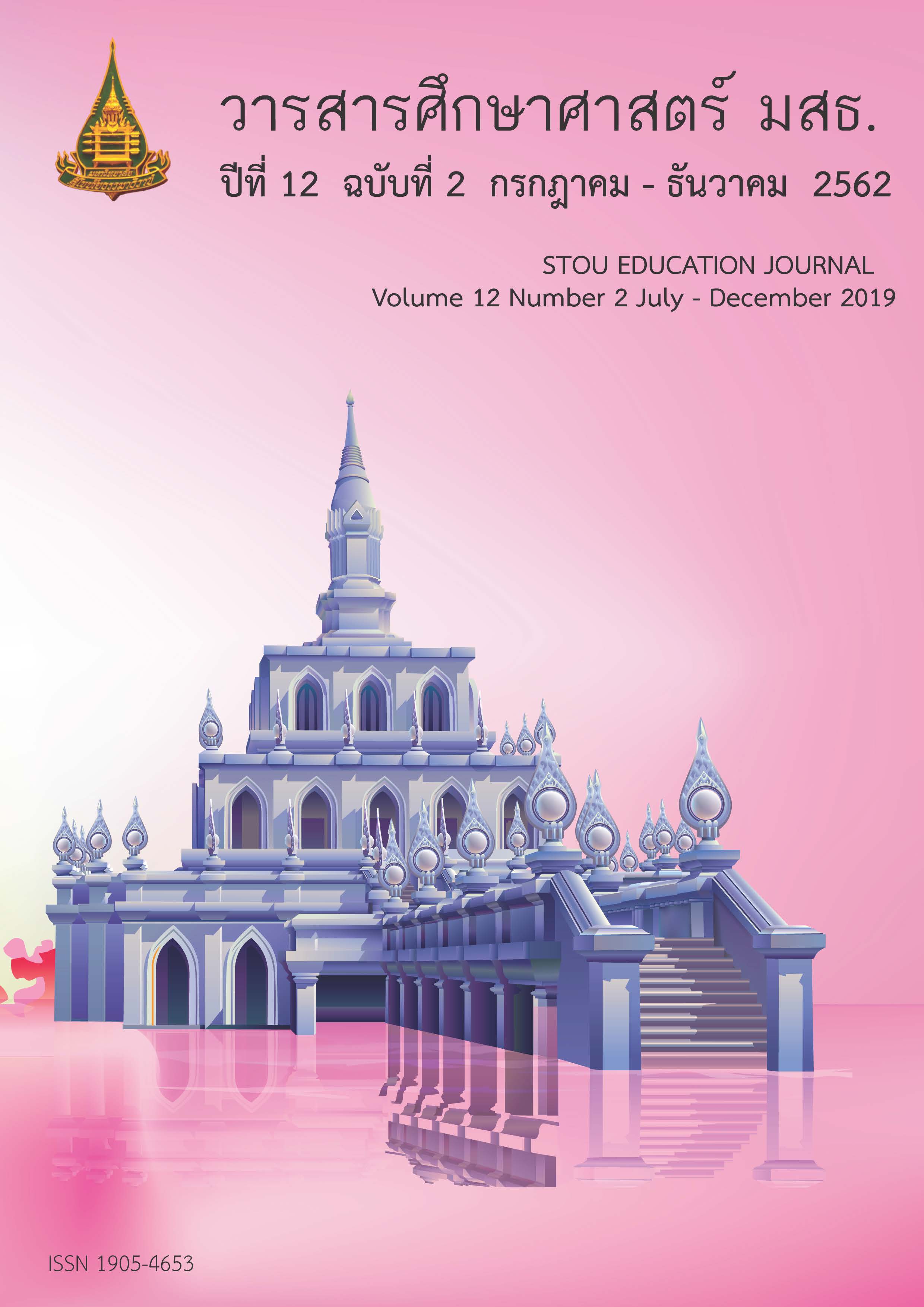การพัฒนารูปแบบการจัดการเรียนการสอนภาษาจีนกลางเป็นภาษาต่างประเทศโดยใช้แนวคิดการสอนแบบบอกเล่าและวิธีสอนแบบฟัง-พูด เพื่อส่งเสริมความสามารถในการฟัง-พูดสำหรับเด็กอนุบาล
Main Article Content
บทคัดย่อ
การวิจัยครั้งนี้มีวัตถุประสงค์เพื่อ 1) พัฒนารูปแบบการจัดการเรียนการสอนภาษาจีนกลางเป็นภาษาต่างประเทศโดยใช้แนวคิดการสอนแบบบอกเล่าและวิธีสอนแบบฟัง-พูด เพื่อส่งเสริมความสามารถในการฟัง-พูดสำหรับเด็กอนุบาล และ 2) ศึกษาผลการใช้รูปแบบที่มีต่อความสามารถในการฟัง-พูดของเด็กอนุบาล กลุ่มตัวอย่าง คือ เด็กอนุบาลชั้นปีที่ 3 จำนวน 19 คน ในโรงเรียนอนุบาลสังกัดสำนักงานคณะกรรมการส่งเสริมการศึกษาเอกชน เครื่องมือที่ใช้ ได้แก่ แบบประเมินความสามารถในการฟัง-พูด และแบบบันทึกความสามารถในการฟัง-พูด วิเคราะห์ข้อมูลโดยการหาค่าร้อยละ ค่าเฉลี่ย ส่วนเบี่ยงเบนมาตรฐาน และการทดสอบค่าที ผลการวิจัยปรากฏว่า 1) รูปแบบการจัดการเรียนการสอนภาษาจีนกลางเป็นภาษาต่างประเทศโดยใช้แนวคิดการสอนแบบบอกเล่าและวิธีสอนแบบฟัง-พูดมีองค์ประกอบสำคัญ 6 องค์ประกอบ ได้แก่ หลักการ วัตถุประสงค์ เนื้อหา ขั้นตอน ระยะเวลา และการประเมินผล ขั้นตอนของรูปแบบมี 3 ขั้น คือ ขั้นนิทานเปิดประสบการณ์ ขั้นฝึกเล่าและขยายประสบการณ์ และขั้นทบทวนความเข้าใจ และ 2) ผลการใช้รูปแบบ พบว่า ค่าเฉลี่ยคะแนนความสามารถในการฟัง-พูดของกลุ่มตัวอย่างหลังการทดลองสูงกว่าก่อนการทดลองอย่างมีนัยสำคัญทางสถิติที่ระดับ .01
Article Details
เอกสารอ้างอิง
ศิริชัย กาญจนวาสี. (2556). ทฤษฎีการทดสอบแบบดั้งเดิม (พิมพ์ครั้งที่ 7). กรุงเทพมหานคร: โรงพิมพ์แห่งจุฬาลงกรณ์มหาวิทยาลัย.
สถาบันเอเชียศึกษา ศูนย์จีนศึกษา. (2551). รายงานผลการวิจัยเรื่องการเรียนการสอนภาษาจีนในประเทศไทยระดับประถมศึกษามัธยมศึกษา. กรุงเทพมหานคร: ศรีบูรณ์คอมพิวเตอร์-การพิมพ์.
Azpillaga, B., Arzamendi, J., Etxeberria, F., Garagorri, X., Lindsay, D, & Joaristi, L. (2001). Preliminary findings of a format-based foreign language teaching method of school children in the Basque Country. Applied Psycholinguistics, 22, 35-44.
Brewster, J. (1991). What is good primary practice?. Teaching English to children: From practice to principle. London: Collin.
Bruner, J. (1975). From communication to language: A Psychological Perspective Cognition, 3(3), 255-287. doi:10.1016/0010-0277(74)90012-2
Cameron, L. (2001). Teaching languages to young learners. Cambridge: Cambridge University Press.
Dalton, T. A. (2011). Comparison of two approaches to improving cognitive academic language proficiency for school-aged, English language learner. All Graduate Plan B and Other Report, 41, 2-43. Retrieved from https://digitalcommons.usu.edu/cgi/viewcontent.cgi?article=1041&context=gradreport
Eaton, S.E. (2010). Global trends in language learning in the twenty-first century. Calgary: Onate.
Glopper, K. D., & Damhuis, R. (2001). Effects of a format-based second language teaching method in kindergarten. Applied Psycholinguistics, 22(1), 1-33.
Griva, E., & Sivropoulou, R. (2009). Implementation and evaluation of an early foreign language learning project in kindergarten. Early Childhood Education, 37(1), 79-87.
Lan, Z. (2013). Scaffolding Chinese teaching and learning. (Master’s Thesis Unpublished). Western Sydney University, Sydney.
Partnership for 21st Century Skill. (2015). 21st Century skills map: Designed in cooperation with the nation’s world language educators. Retrieved from: http://P21.org
Richard-Amato, P. A. (2003). Making it happen: Interaction in the second language classroom, from theory to practice (2nded). New York: Longman.
Richards, J. C., & Rodgers, T. S. (2014). Approaches and methods in language teaching (3rd Ed.). United Kingdom: Cambridge University Press.
River, W. M. (1981). Teaching foreign language skill. Chicago: University of Chicago Press.
Shaaban, K. (2001). Assessment of young learners. Teaching Forum, 99(4), 16-23.
Strickland, D. S., Galda, L., & Cullinan, B.E. (2004). Language art learning and teaching. Canada: Thomson Learning.
Syahputra, F. P. (2014). Comparative analysis between audio-lingual and total physical response methods in English language learning for kindergarten students. Retrieved from: http://repository.usu.ac.id/handle/123456789/43250
Taeschner, T. (2013). The narrative format for learning and teaching language to children and adults. Innovative approaches to language teaching and learning through International Projects. Synergy, 9, 223-235. Retrieved from: https://www.ceeol.com/search/article-detail?id=71551.


